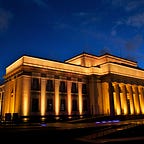Translating User Interfaces into te reo Māori
Auckland Museum Tāmaki Paenga Hira seeks to be a kaiāwhina (advocate) in the revitalisation and retention of te reo Māori. As a step toward this, we have recently translated our Collections Online and Online Cenotaph user interfaces into te reo Māori. This work was made possible by an InternetNZ grant; their most recent funding round focused on projects that support digital inclusion in Aotearoa. The translation means that users can now search and read about our records in both te reo Pākehā and te reo Māori.
→ Read this article in te reo Māori.
Digital Inclusion
Auckland Museum is committed to making its digital collections widely available. Providing a bilingual user interface for Online Cenotaph and Collections Online signals our commitment to normalising the use of te reo Māori. We have also translated some of our Cenotaph Story pages. Our work is guided by the Maihi Karauna, the Crown’s Strategy for Māori Language Revitalisation 2019–2023.
By broadening access to both fluent speakers and those wishing to learn te reo, we are playing our part in supporting the government’s target of enabling one million New Zealanders to speak the language by 2040. It is our aspiration that both Online Cenotaph and Collections Online will become resources for students at Kura Kaupapa Māori and mainstream schools. This aligns with InternetNZ’s focus on projects which support digital inclusion in Aotearoa, as well as the museum’s He Korahi Māori philosophy.
Supporting digital inclusion initiatives such as this is an important step in language planning and revitalisation and shows how vital community support is to the normalisation of te reo Māori — Tracy Maniapoto
Our current Sir Hugh Kawharu Scholarship recipient, Tracy Maniapoto (Ngāti Tūwharetoa, Te Atihaunui-ā-Pāpārangi and Ngāti Kahungunu ki Te Wairoa), is completing her PhD in Māori Studies at Massey University’s Te Pūtahi-a-Toi (School of Māori Knowledge).
Tracy is exploring the relationships between te reo Māori revitalisation, adult language learners, GLAM-sector (galleries, libraries, archives and museums) cultural-heritage institutions and Māori social and cultural aspirations. She believes that “[s]upporting digital inclusion initiatives such as this is an important step in language planning and revitalisation and shows how vital community support is to the normalisation of te reo Māori”.
He Korahi Māori: A Māori Dimension
This project builds on the work of many current and former museum staff and members of the Taumata-ā-Iwi. In 2012 the Taumata-ā-Iwi gifted the museum He Korahi Māori: A Māori Dimension. This is a cultural philosophy based on the spirit of partnership and goodwill envisaged by Te Tiriti o Waitangi that leads our vision to be a bi-cultural organisation. By making the museum’s collections accessible in te reo Māori, this project contributes to our vision to increase the visibility of te reo and Taonga Māori collections.
Te reo māori me ōna tikanga and the guiding principles of He Korahi Māori provide the foundation for te reo Māori at Tāmaki Paenga Hira to ensure the quality, clarity, consistency and authentic use of te reo Māori across the Museum’s business and activities ¹
This functionality not only benefits our wider public but also supports the wellbeing of the Museum staff, as our Tumuaki Director Māori, Dion Peita, recently noted: “As a te reo Māori speaker, Museum professional and a parent whose tamariki attend kura kaupapa an investment such as this is welcome.”
We acknowledge that this is only a first step as we are simply translating from reo Pākehā to te reo Māori. In the future we would like to use Mātauranga Māori to inform the choice of the correct kupu (words) and kōrero (phrases), as well as the overall design and development of both Collections Online and Online Cenotaph.
The technical stuff
We worked with NZTC International on this project. NZTC has a rigorous quality assured process, which is ISO-17100-certified and includes translation by their professional native-speaker translators with experience in te reo Māori translations of user interfaces, as well as translating for a Northern Māori style most appropriate for our users in Tāmaki Makaurau Auckland.
The aim of this project was to make the museum’s collections and digital-research platforms more accessible to those fluent in te reo, with a secondary goal of providing a learning resource for Kura Kaupapa to use in the new Aotearoa New Zealand history curriculum. The introduction of te reo Māori in our user interfaces also helps to introduce kupu to those new to the language. Increasing the visibility of te reo in our everyday lives is key to its revitalisation.
This is an innovative project: very few New Zealand GLAM institutions have bilingual interfaces. We note that AUT has recently translated their Library Catalogue, which is fantastic. Among the other institutions with a commitment to normalising te reo Māori are Ngā Taonga Sound & Vision, who have bilingual online exhibitions and have run te reo cataloguing projects, and Otago Otago Museum’s Taoko Digitisation Project, which has dual language interface labels and a Taoka Māori Thesaurus.
We would love to see more of this out in the world. We know that budgets are tight at the moment, so we are pleased to release the translations under a CC-BY licence, so they can be used and repurposed by other institutions. The translation strings will be uploaded to Zenodo and our Github soon.
Future aspirations
This work is a pilot project for achieving our aspirations of making our digital collections available in multiple languages. It is also a first step in our long-term Collections Online and Online Cenotaph roadmap, which has a workstream focused on providing better access to our collections — which we believe can be further enhanced and amplified by providing multilingual metadata, and which we hope contributes to increasing digital inclusion in Aotearoa New Zealand.
Kia kaha te reo Māori!
¹ Auckland Museum te reo Māori Strategic Framework
